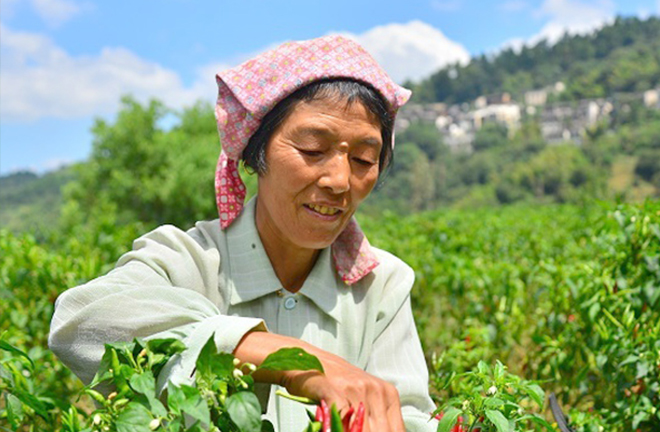Agricultural subsidy underpins food security

A farmer picks chilli in Wuyuan County, Jiangxi Province, where subsidies have become an important source of income. Photo: XINHUA
As the bedrock and stabilizer of economic and social development, agriculture is especially important for developing or population-dense countries. Since natural production and economic production are intertwined in agricultural production, risks both natural and economic coexist in agriculture. This makes support and guidance from government policies particularly crucial for agricultural production. Subsidizing agriculture is a common practice in most countries to support agricultural development in order to protect vulnerable industries and ensure food security.
Since 2004, China has gradually established an agricultural subsidy system based on subsidies for superior crop varieties, direct subsidies for grain planting, subsidies for the purchase of agricultural machinery and tools, and comprehensive subsidies for agricultural materials. Agricultural taxes in China were abolished in 2006, and the scope of the subsidies and crop varieties covered also expanded. Apart from rice, wheat, and corn, crop varieties covered also began to include potato, cotton, peanut, highland barley and others. The agricultural subsidy system has been gradually improved and optimized.
The total agricultural subsidy of China has been increasing from RMB 14.5 billion to RMB 165.2 billion in 2004-2016, an increase of more than ten times. Given low earnings from agricultural products and rapid growth of agricultural production costs, subsidies have become an important way for farmers to increase their income. According to a survey conducted by Shanghai University of Finance and Economics on 243 rural areas of prefecture-level cities in 31 provinces in 2019, the average subsidy for land-protection per mu (a unit of area, about 0.06 hectares) obtained by Chinese farmers surpassed RMB 100. The agricultural subsidy given to families constitutes an important source of their income.
Price is the key to allocation of production factors. Shifting prices of agricultural input factors caused by agricultural subsidies will inevitably lead to the adjustment of factor and resource allocation. Especially in this transitional period when China is transforming its traditional agriculture sector to a modern one, it is necessary to realize the optimal allocation of agricultural factors with high output, including that of land, capital and labor.
Since the enactment of Document No. 1 of the Central Government, which encouraged the gradual transfer of land to farmers with expertise, transaction of land management rights have been gradually granted to farmers. The input of machinery in agricultural production has thus been increasing, the comprehensive mechanization rate reached 69% by 2018, which not only improved production efficiency but also resulted in a large surplus of agricultural labor force. With the development of non-agricultural sectors and the advancement of urbanization, a large number of agricultural labor forces have been transferred across sectors and regions, as laborers seek higher income and living conditions. In 2019, the total number of migrant workers in China reached 290.77 million. With the acceleration of labor factor movements, labor factor in agricultural production becomes relatively scarce, capital factor input gradually increases, and land factor gradually expands at a large scale. In this way, by increasing income for farmers and adjusting prices of production factors, agricultural subsidies secure the optimal allocation of factors of production and resources. This not only helps form an incentive mechanism for agricultural production, but also promotes the transformation of agricultural production to modern models.
Kang Jiaojiao and Wu Fangwei are from the Research Institute for Agriculture, Farmer and Rural Society in China at Shanghai University of Finance and Economics.
edited by BAI LE
